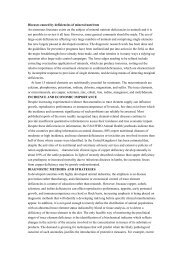Technological and Technical Development of Tobacco Drying
Technological and Technical Development of Tobacco Drying
Technological and Technical Development of Tobacco Drying
You also want an ePaper? Increase the reach of your titles
YUMPU automatically turns print PDFs into web optimized ePapers that Google loves.
Every year we emphasize to do topping <strong>and</strong> sucker control in an early time, because these technology<br />
elements have a large influence for the quality <strong>and</strong> ripening time.<br />
Last <strong>and</strong> this year some trials were made to evaluate the influence <strong>of</strong> the ripeness. The experience was,<br />
that the degree <strong>of</strong> maturity had a considerable influence on the yield <strong>and</strong> quality <strong>of</strong> tobacco (Kerekes,<br />
1999).<br />
The Table 1. shows the effect <strong>of</strong> degree <strong>of</strong> maturity at harvest on yield, quality category, nicotine content,<br />
carbohydrate <strong>and</strong> income.<br />
Table 1. Influence <strong>of</strong> maturity on some features<br />
Treatment Yield<br />
t/ha<br />
Quality<br />
category<br />
(Class)<br />
Unriped 2,13 2 nd , 3 rd<br />
Riped 2,04 1 st<br />
Overriped 1,93 1 st , 2 nd<br />
Nicotine<br />
content<br />
%<br />
Carbohydrate<br />
%<br />
Income<br />
%<br />
3,63 15,94 83<br />
1,21 29,86 100<br />
2,55 15,17 91<br />
In these tests the unriped tobacco lacked about one week <strong>of</strong> being as ripe as the growers prefer for<br />
harvesting. The overriped tobacco stayed in the field about 7 days longer than usual.<br />
These data showed a reduction in yield with a delay in harvest. The quality <strong>of</strong> the cured tobacco was<br />
worse, when the tobacco differed from the ripped condition. The nicotine content considerably high,<br />
when the tobacco unriped or overriped, comparing with the optimum harvesting. The amount <strong>of</strong> the<br />
carbohydrate was half <strong>of</strong> the required rate.<br />
The income was increased from unriped to ripped, but was decreased when the tobacco became<br />
overriped.<br />
In Hungary the racks are sometimes loaded at the barns <strong>and</strong> not directly on the field. It means more<br />
working time <strong>and</strong> labour, as well as the leaves sustain a loss.<br />
The <strong>Tobacco</strong> Processing Corporation - with my cooperation - elaborated a proposal for h<strong>and</strong>-harvesting:<br />
the farmers can gather the tobacco leaves directly into the racks placed on a special vehicle, which are<br />
transported immediately to the barns.<br />
In some cases it was used bins instead <strong>of</strong> racks, but it was found, that the loading never was perfect so<br />
that the curing was not so successful. The quality <strong>of</strong> the dried leaves was poor <strong>and</strong> the curing time<br />
increased significantly.<br />
In the tobacco farms the workers strive to load full one barn during a day. But sometimes it happens, they<br />
load the racks unevenly so that it does not develop a uniform air-circulation through the racks.<br />
In loading bulk kilns, it must be pushed the racks tightly together to ensure, that the air will move through<br />
the leaves rather than between the racks. Also, it has to be closed <strong>of</strong>f any space between the racks <strong>and</strong><br />
loading doors with fiberboard or other material.<br />
Despite the technical development, the purpose was to improve the quality <strong>of</strong> the cured tobacco <strong>and</strong><br />
decrease the energy dem<strong>and</strong> by working out a modified drying technology.<br />
During application <strong>of</strong> the conventional curing process, the cure man has to strive for that the wet-bulb<br />
temperature remains at about 30-35 o C, disregarding the start <strong>and</strong> finish phases. The relative humidity in<br />
the barn is lower <strong>and</strong> decreases rapidly.<br />
The degree <strong>of</strong> air changing is determined by this rule. It means that we have to open the external air<br />
louver <strong>of</strong> the barn too <strong>of</strong>ten <strong>and</strong> for a longer time. This conventional technology requires much more<br />
energy for curing <strong>and</strong> disadvantageous for the chemical components <strong>of</strong> the end-product (Kerekes, 1996).<br />
The developed experimental curing features are demonstrated in the following figures. The change <strong>of</strong><br />
temperature <strong>and</strong> relative humidity are shown in Figure 1. <strong>and</strong> 2.















